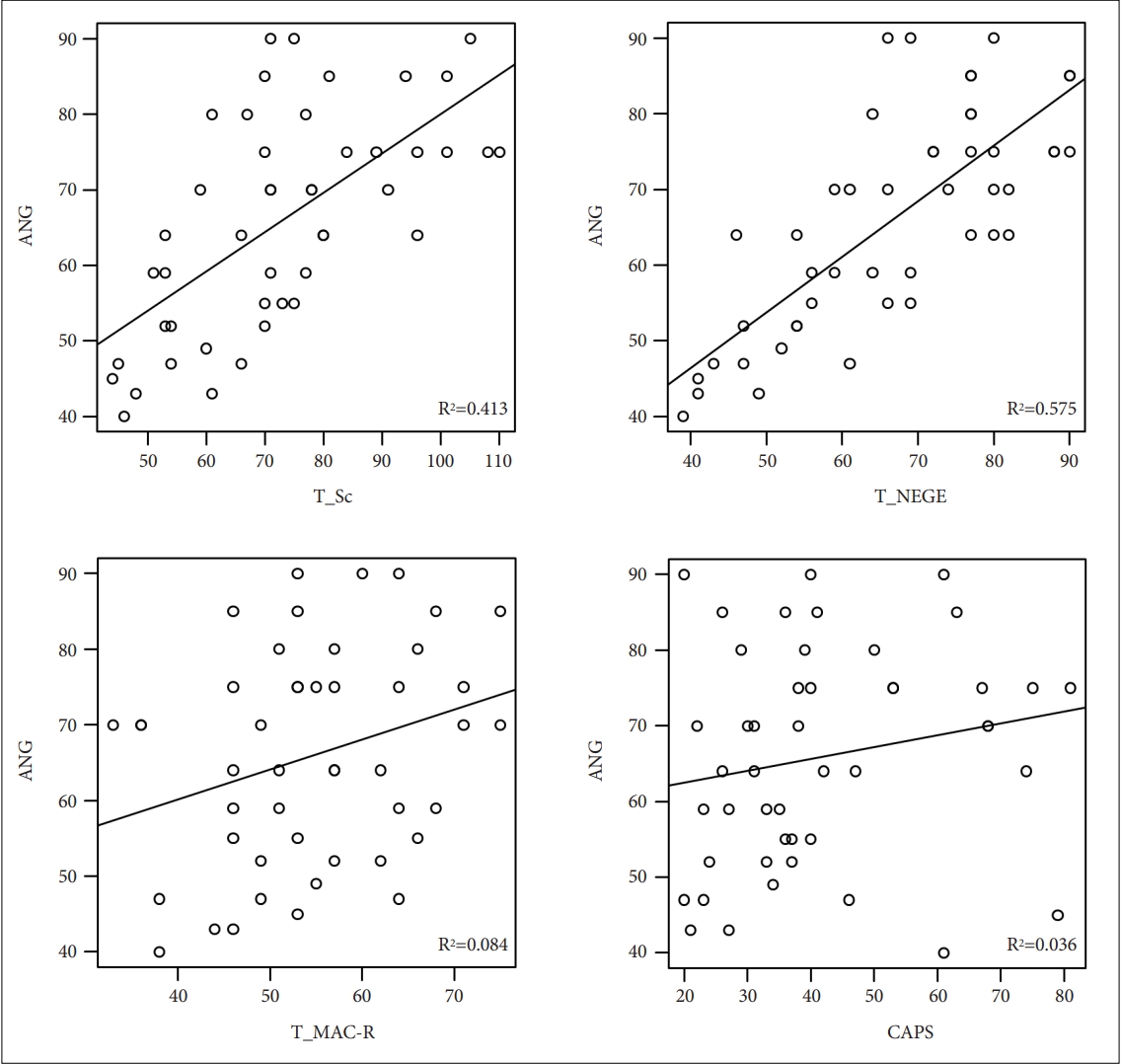 |
 |
- Search
| Psychiatry Investig > Volume 19(11); 2022 > Article |
|
Abstract
Objective
Methods
Results
Notes
Availability of Data and Material
The datasets generated or analyzed during the study are available from the corresponding author on reasonable request.
Conflicts of Interest
The authors have no potential conflicts of interest to disclose.
Author Contributions
Conceptualization: Hayun Choi. Data curation: Sungsuk Je, Seon Namgung. Formal analysis: Sungsuk Je, Hayun Choi. Funding acquisition: Hayun Choi. Investigation: Sungsuk Je. Methodology: Sungsuk Je, Hayun Choi. Project Administration: Sungsuk Je, Hayun Choi. Resources: Hayun Choi, Kiwon Kim, Hyung Seok So, Jin Hee Choi, Seung-Hoon Lee. Software: Sungsuk Je, Hayun Choi. Supervision: Hayun Choi. Validation: Sungsuk Je. Visualization: Sungsuk Je, Hayun Choi. Writing—original draft: Sungsuk Je. Writing—review & editing: Hayun Choi.
Funding Statement
This study was supported by a VHS Medical Center Research Grant from the Republic of Korea (Grant number: VHSMC 20008).
ACKNOWLEDGEMENTS
Figure 1.

Figure 2.

Table 1.
| Trauma exposed without PTSD (N=29) | PTSD (N=46) | p value† | ||
|---|---|---|---|---|
| Age at CAPS* (yr) | 66.45±12.08 | 57.43±18.77 | 0.044 | |
| Sex (M) | 28 | 42 | 0.727 | |
| Education | 11.43±4.70 | 11.98±3.54 | 0.661 | |
| CAPS** | 9.79±5.91 | 41.85±17.20 | <0.001 | |
| CES-K | 13.29±9.41 | 11.37±9.90 | 0.570 | |
| MMPI-2 clinical scales (T score) | ||||
| Hypochondriasis (T_Hs) | 64.79±14.41 | 68.76±14.54 | 0.354 | |
| Depression (T_D) | 67.17±14.22 | 67.93±13.36 | 0.883 | |
| Hysteria (T_Hy) | 63.03±13.88 | 60.76±9.83 | 0.566 | |
| Psychopathic Deviate (T_Pd) | 60.76±14.19 | 67.07±16.55 | 0.163 | |
| Masculinity/Feminity (T_Mf) | 50.10±12.68 | 53.87±8.87 | 0.251 | |
| Paranoia* (T_Pa) | 60.45±14.98 | 71.63±19.50 | 0.029 | |
| Psychasthenia (T_Pt) | 63.52±14.51 | 71.28±14.46 | 0.063 | |
| Schizophrenia* (T_Sc) | 61.14±14.90 | 72.91±17.55 | 0.020 | |
| Hypomania (T_Ma) | 49.79±9.22 | 54.91±9.16 | 0.056 | |
| Social Introversion (T_Si) | 60.07±14.60 | 63.37±13.24 | 0.421 | |
| Restructured clinical scales | ||||
| Demoralization (RCd) | 61.21±13.82 | 67.46±13.23 | 0.109 | |
| Somatic Complaint (RC1) | 62.59±15.62 | 68.00±15.16 | 0.215 | |
| Low positive emotions (RC2) | 61.14±15.36 | 61.46±12.90 | 0.960 | |
| Cynicism (RC3) | 53.59±12.79 | 56.93±12.74 | 0.372 | |
| Antisocial Behavior (RC4) | 50.10±9.83 | 57.13±14.72 | 0.063 | |
| Ideas of persecution** (RC6) | 54.03±13.09 | 67.28±18.46 | 0.009 | |
| Dysfunctional Negative Emotions (RC7) | 59.28±13.90 | 65.09±14.44 | 0.160 | |
| Aberrant Experiences* (RC8) | 58.00±12.05 | 67.22±16.91 | 0.030 | |
| Hypomanic Activation (RC9) | 48.28±9.08 | 51.85±8.90 | 0.163 | |
| PSY-5 Scales | ||||
| Aggressiveness* (T_AGGR) | 47.00±7.54 | 53.61±9.85 | 0.020 | |
| Psychoticism* (T_PSYC) | 57.10±13.40 | 68.30±19.98 | 0.023 | |
| Disconstraint (T_DISC) | 47.41±11.68 | 49.46±13.50 | 0.596 | |
| Negative Emotionality/Neuroticism* (T_NEGE) | 58.07±13.70 | 66.57±14.73 | 0.045 | |
| Introversion/low positive emotionality (T_ INTR) | 61.31±15.05 | 62.07±15.21 | 0.885 | |
| Content scale | ||||
| Anger* (T_ANG) | 56.21±12.77 | 65.93±14.25 | 0.020 | |
| Supplementary scale | ||||
| MacAndrew Alcoholism-Revised (T_MAC-R) | 49.97±8.31 | 54.65±10.46 | 0.098 | |
Table 2.
|
CAPS |
Anger |
||||
|---|---|---|---|---|---|
| R‡ | p-value† | R‡ | p-value† | ||
| MMPI-2 clinical scales (T score) | |||||
| Hypochondriasis** (T_Hs) | 0.037 | 0.925 | 0.501 | 0.001 | |
| Depression* (T_D) | 0.122 | 0.828 | 0.381 | 0.011 | |
| Hysteria* (T_Hy) | 0.028 | 0.925 | 0.315 | 0.039 | |
| Psychopathic Deviate** (T_Pd) | 0.048 | 0.925 | 0.522 | <0.001 | |
| Masculinity/Feminity (T_Mf) | -0.045 | 0.925 | 0.237 | 0.116 | |
| Paranoia** (T_Pa) | 0.149 | 0.828 | 0.581 | <0.001 | |
| Psychasthenia** (T_Pt) | 0.106 | 0.855 | 0.650 | <0.001 | |
| Schizophrenia** (T_Sc) | 0.187 | 0.828 | 0.642 | <0.001 | |
| Hypomania* (T_Ma) | -0.099 | 0.875 | 0.306 | 0.044 | |
| Social Introversion** (T_Si) | 0.215 | 0.828 | 0.404 | 0.007 | |
| Restructured clinical scales (RC scales) | |||||
| Demoralization (RCd)** | 0.124 | 0.828 | 0.616 | <0.001 | |
| Somatic Complaint (RC1)** | 0.040 | 0.925 | 0.470 | 0.002 | |
| Low positive emotions (RC2)* | 0.324 | 0.640 | 0.387 | 0.010 | |
| Cynicism (RC3)** | 0.026 | 0.925 | 0.491 | 0.001 | |
| Antisocial Behavior** (RC4) | 0.089 | 0.912 | 0.430 | 0.004 | |
| Ideas of persecution** (RC6) | 0.083 | 0.923 | 0.569 | <0.001 | |
| Dysfunctional Negative Emotions (RC7)** | 0.150 | 0.828 | 0.639 | <0.001 | |
| Aberrant Experiences* (RC8)** | 0.013 | 0.952 | 0.555 | <0.001 | |
| Hypomanic Activation (RC9)** | -0.120 | 0.828 | 0.477 | 0.001 | |
| PSY-5 Scales | |||||
| Aggressiveness** (T_AGGR) | -0.043 | 0.925 | 0.518 | <0.001 | |
| Psychoticism** (T_PSYC) | 0.039 | 0.925 | 0.520 | <0.001 | |
| Disconstraint (T_DISC) | 0.163 | 0.828 | 0.135 | 0.372 | |
| Negative Emotionality/Neuroticism** (T_NEGE) | 0.166 | 0.828 | 0.758 | <0.001 | |
| Introversion low positive emotionality* (T_ INTR) | 0.361 | 0.628 | 0.758 | 0.044 | |
| Content scales | |||||
| Anger (T_ANG) | 0.189 | 0.828 | |||
| Supplementary scales | |||||
| MacAndrew Alcoholism-Revised (T_MAC-R) | -0.114 | 0.828 | 0.290 | 0.054 | |
Table 3.
REFERENCES
-
METRICS

-
- 0 Crossref
- Scopus
- 2,901 View
- 76 Download
-
Functional Impairment in Patients with Panic Disorder2021 May;18(5)






